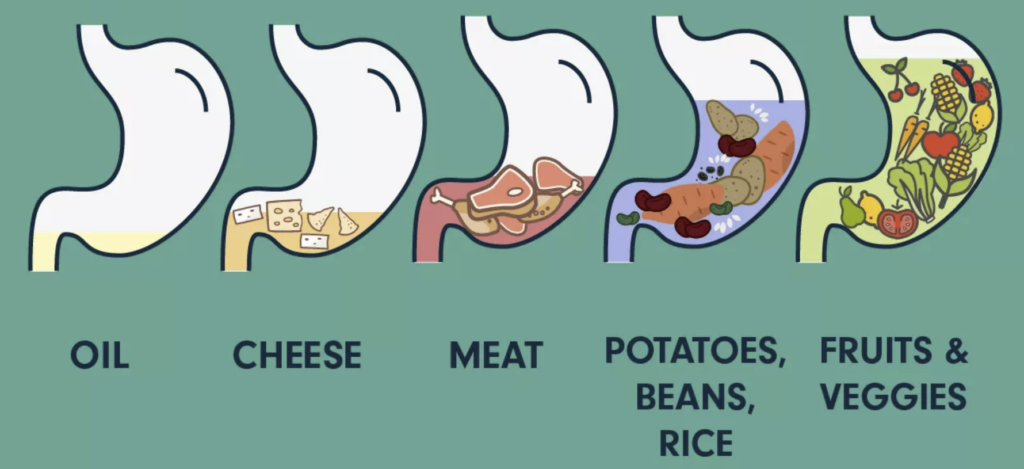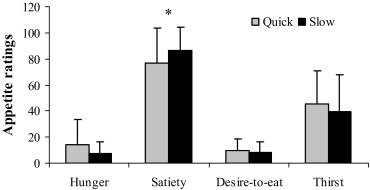How humans eat today is incomparable to the diets of our ancestors. It’s astonishing. We weren’t designed to consume hyperpalatable foods. Our meals didn’t terminate after ten minutes. And the variety was limited. Here I’m going to detail how humans are designed to eat so you can transform your eating habits. Let’s get into it!
Energy Density
Look at the three foods below. These foods were assigned to study participants for consumption three times a day. Across the study, one food performed worse. Which food was it?

Food A is an apple, food B is a pear, and Food C is an oat cookie. All three foods were selected to have similar macronutrients. Yet the oat cookie was the only food that caused excess caloric intake and weight gain. Why? Energy density. [1]

Energy density is the number of calories per gram of food. Since people tend to eat a consistent weight of food, when the energy of the available food is reduced, energy intake is reduced [2]. The apple and pear weigh 300grams while the cookie only 60grams. Despite having the same calories, the cookie is less filling. It’s more energy dense.
Humans are designed to eat whole foods. Whole foods like fruits, vegetables, legumes, and whole grains are not energy dense. They take up more room in the stomach. On the other hand, processed food, bread, oils, fatty meats and cheeses are energy dense [3]. They’re easy to overeat. They take up less room in the stomach. And this causes you to feel less satiated. It’s why a 200-calorie apple is more filling than a 200-calorie cookie. Humans weren’t designed for energy dense foods. (An exception being nuts and seeds)
Eating Session Duration
A side effect of consuming energy dense foods is the decrease in eating duration. For lunch yesterday, I ate my typical perfect lunch. Salad, soup, and side of fruit. It’s packed with energy-sparce whole foods. It took me 20 minutes to eat the salad, 10 for the soup, and 5 for the berries. It takes me forever to eat. It’s like a workout for my jaw. If only you could see these built masseters. Yet I’m full and satisfied.

For dinner, I ordered an energy-dense meal. Pizza and a cookie for dessert. More calories than at lunch. Yet I ate the pizza in 8 minutes and the cookie in 1. This certainly isn’t a highly controlled study, but the concept is clear. I consumed the energy-dense meal four times faster. That’s staggering. Eating meals slowly decreases hunger, thirst, and desire-to-eat [5]. But it’s near impossible to consistently eat hyperpalatable energy-dense meals slowly. Whole foods don’t provide an option. There’s too much chewing and swallowing to eat rapidly. Humans are designed to eat calories slowly. Humans are designed for whole foods.
Food Variety
Last week I mentioned how eating a variety of food is associated with overeating and weight gain. The exception is whole foods. A variety of fruits and vegetables is associated with weight loss. That’s because it maximizes our micronutrient intake while not overeating. Variety is good when the food is good. [6]
Final Thoughts
I can easily eat a pizza and cookie in under 10 minutes and still be hungry. Yet I struggle to finish a salad, soup, and side of fruit after half an hour. Similar calories, different results. This is because humans were designed to consume calories slowly. Those calories should be energy space. And this just isn’t possible with many processed foods or animal products. Humans were designed to eat whole foods slowly. And take massive poops as a result. That’s a weird ending to the post.

Hi, I’m Brandon Zerbe
Welcome to myHealthSciences! Every week I share habits for health excellence. I do this by covering topics like Fitness, Nutrition, Sleep, Cognition, Finance and Minimalism. You can learn more about me here.
Sources:
- [1] A Low-Energy-Dense Diet Adding Fruit Reduces Weight and Energy Intake in Women
- [2] The Relationship Between Dietary Energy Density and Energy Intake
- [3] A Common Sense Approach to Sound Nutrition
- [4] The Calorie Density Approach to Nutrition and Lifelong Weight Management
- [5] Eating Slowly Led to Decreases in Energy Intake Within Meals in Healthy Women
- [6] Variety, Palatability, and Obesity
- [Supplemental] Eating More to Weigh Less
